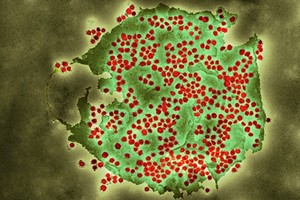COVID-19 prevalence continues to decline across England but infection rates remain high
Findings from the latest report of the government-backed REACT-1, one of the largest studies into coronavirus (COVID-19) infections in England, have been published today.

Over 94,000 volunteers in England took part in the study to examine the levels of COVID-19 in the general population between 8 February and 1 March.
The latest findings from Imperial College London and Ipsos MORI, covering 8 February to 1 March 2022 (round 18 of the study), show that prevalence in England during this period was 2.88%, significantly down on the 4.41% reported in round 17 (covering January 5 to January 20 2022), but the second highest recorded rate of prevalence rate since the study began in 2020. This means that during the period in which swabs were collected, approximately 1 in 35 people in England were infected with the virus.
Rates of Omicron sub-lineage BA.2 were highest in London, standing at 44.3% of all positive cases in the region. Proportions of BA.2 were also found to be higher in the southern regions compared with the Midlands and northern areas of the country.
While prevalence rates have fallen in all age groups in round 18 from round 17, trends suggest a level or increasing prevalence among those aged 55 and over within this latest round.
Dr Jenny Harries, Chief Executive of the UK Health Security Agency (UKHSA), said:
This data confirms that cases have declined substantially following the peak of the Omicron wave.
However, the increasing presence of the BA.2 sub-lineage of Omicron and the recent slight increase in infections in those over 55 shows that the pandemic is not over and that we can expect to see COVID-19 circulating at high levels.
Vaccination remains the best way to protect us all from severe disease and hospitalisation due to COVID-19 infection. We urge you to come forward for your primary or booster doses straight away if you have not already done so.
Health and Social Care Secretary Sajid Javid said:
It is reassuring to see that COVID-19 cases have continued to fall as we learn to live with the virus and regain our freedoms.
We must continue to protect each other where necessary. Vaccines remain our best line of defence against the virus. If you haven’t already, please Get Boosted Now.
Professor Paul Elliott, director of the REACT programme from Imperial’s School of Public Health, said:
It’s encouraging that infections have been falling across England, but they are still very high and the possibility that they are rising in older adults may be cause for concern.
The good news is that this is a highly vaccinated group. However, a high number of infections will lead to more people becoming ill, so it’s important that people continue to follow public health guidance to avoid fuelling further spread of the virus.
Kelly Beaver, CEO at Ipsos MORI, said:
It is very positive to see prevalence falling month on month, but vigilance remains critical particularly with the concern that we may be seeing a small uptick in cases among the elderly.
REACT has been a vital epidemiological tool over the last 2 years and we would like to thank the over 3 million people who have taken part across the various studies, for contributing to this incredibly important research.
The main findings from the report are as follows:
There were 2,731 positives from 94,950 swabs in round 18, giving an overall weighted prevalence of 2.88%. This is a significant decline in weighted prevalence from round 17, where the figure stood at 4.41%.
A total 1,195 viral lineages were determined from positive samples up to 21 February, all but one of which were the Omicron variant. Of these lineages, 32.7% corresponded to BA.1, 39.6% to BA.1.1 and 27.7% to BA.2.
There was an estimated daily growth rate advantage for BA.2, compared with the 2 other sub-lineages of Omicron with an additive advantage in R of 0.40. The proportion of BA.2 nationwide was estimated at 47.2% as of 21 February 2022.
The highest proportion of BA.2 in this round was observed in London, standing at 44.3%. The next highest proportion of BA.2 prevalence was found in the South West and, in general, BA.2 prevalence was higher in the southern regions compared to the Midlands and northern regions in round 18.
Weighted prevalence was highest in those aged 5 to 11, standing at 4.69%, and lowest in those aged over 75, standing at 1.68%. While prevalence fell in all ages from the previous round, trends suggest a level or increasing in-round weighted prevalence in those aged 55 and above.
Weighted prevalence fell in all regions between round 17 and 18, except in the South East and South West. Weighted prevalence in the South East rose slightly to 3.33% from 3.23%, and in the South West to 3.12% from 2.92%.
At a lower-tier local authority level, of the 10 highest smoothed estimates of prevalence based on a nearest neighbour method, 6 were in London and 4 were in the South West of the country. The local authorities in question were Lambeth, Croydon, Sutton, Merton, Camden, Wandsworth, Bath and North East Somerset, City of Bristol, South Gloucestershire and North Somerset.